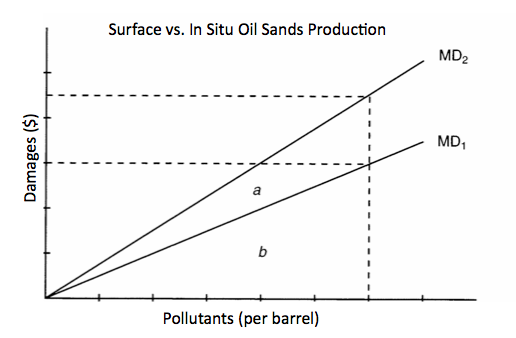Course:ECON371/UBCO2011WT1/GROUP8/Article 1: Hard Evidence, Missing Data, New Promises
Return to Group 8:
Alberta's Oil Sands: Hard Evidence, Missing Data, New Promises
Article1:
Summary
The article outlines a report by the Royal Society of Canada (RSC) cited substantial evidence that efforts to extract oil from Alberta deposits have degraded air, land, and water quality to varying degrees. The panel said that there appears to be no significant human health threats to the general population now or expected in the next decade of development. The panel also mentions major gaps in health and environmental data, risk assessment, government oversight, information transparency, industry efforts, and disaster preparedness. The evidence does not support the claim by some critics of the oil sand industry, that it is the most environmentally destructive project on earth. The article then goes to discuss the different extracting methods and their trade offs. Surface mining, which involves extracting bitumen down to a depth of 75 m accounts for 20% of the estimated reserves and 55% of current bitumen extraction. Surface mining disrupts land and leads to tailing ponds, which contain toxic substances. The other method, in situ, involves drilling down and using steam heat to liberate the bitumen. In situ has a carbon footprint one third bigger greater that that of surface mining and has risks of groundwater contamination. While there are concrete environmental implication the repot states that there is a lot of uncertainty into the true extent of the environmental tradeoffs.
Economic Analysis
From an economic perspective, oil sands production is one of the most prominent issues regarding Canada’s Green House Gas Emission (GHG). Currently speaking, oil sands production contributes to 5% of the total GHG emissions in the country even though emissions per barrel of bitumen in Alberta are decreasing. Now only is oil production responsible GHG gas emissions, but it also causes water pollution, land destruction through toxic substances and air pollution.
Regarding the article chosen our group has decided to concentrate on the two different types of drilling available in an economic sense. The first and most feasible process is surface mining, which accounts for 55% of the available bitumen for extraction. This type of drilling is prevalent as is can be used to extract the resource at depths up to 75 meters. The second drilling process, that is said to dominate bitumen production by 2015, is steam heating otherwise known as “in situ”. This extraction method is used for deposits that are deeper than 150 meters.
The diagram above compares the marginal damage curves of each extraction method. The first curve (MD1) shows the surface mining method for bitumen deposits that is less expensive and better for the environment than “in situ” extraction. The second curve (MD2) shows the more expensive and environmentally harmful method, which involves steam heating extraction. This goes to show that the deeper the extraction for bitumen the greater the costs to the country.
Another way to look at the costs of digging in an economic sense is to consider the environmental tradeoffs that have resulted. As water is extracted from the River Athabasca for example, the river flow has fallen about 25-30% since the mid 1970’s. The industrial contaminants are dumped in he river which has severely affected the fish species. Many species are on the edge of extinction and there have been more than 2000 waterfowl that have died due to wastewater drained into the tailing ponds.
Prof Comments
Your analysis is consistent with your summary, provided you focus on GHG. However, I don't see the article.
I would have liked to see some discussion of the other environmental impacts beyond GHG that differ between the two methods you discussed. In situ has higher GHG production, but causes far less habitat destruction and related damages on the surface. Thus, if we were to compare all costs and benefits, the difference might not be as large.
8/10
